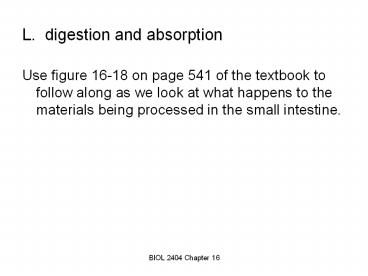L. digestion and absorption - PowerPoint PPT Presentation
Title:
L. digestion and absorption
Description:
... vitamins are absorbed along with food. a. most water soluble vitamins (B, ... b. the fat soluble vitamins (A, D, E, K) are absorbed along with lipids from food ... – PowerPoint PPT presentation
Number of Views:245
Avg rating:3.0/5.0
Title: L. digestion and absorption
1
L. digestion and absorption
- Use figure 16-18 on page 541 of the textbook to
follow along as we look at what happens to the
materials being processed in the small intestine.
2
- 1. carbohydrates
- salivary amylase works during chewing to break
starch and glycogen down into disaccharides
(mostly maltose) - salivary amylase is inactivated once the food
gets to the stomach - when food arrives in the duodenum, pancreatic
amylase continues the breakdown of starch and
glycogen into disaccharides - when the disaccharides are pushed up against the
intestinal mucosa epithelial cells, the
intestinal epithelial enzymes break all
disaccharides (maltose, sucrose and lactose) down
into monosaccharides (glucose, fructose and
galactose) - the monosaccharides are absorbed through
intestinal epithelial cells into vascular
capillaries
3
- 2. proteins
- when food reaches the stomach, the stomach
secretes the enzyme pepsin - pepsin breaks proteins and peptides in the chyme
down into smaller peptides (chains of amino
acids) - when chyme reaches the duodenum, pancreatic
proteases continue to break the peptides down
into smaller and smaller sections (mostly
dipeptides) - when the dipeptides are pushed up against the
intestinal mucosa epithelial cells, the
intestinal epithelial enzymes break all
dipeptides down into amino acids - the amino acids are absorbed through intestinal
epithelial cells into vascular capillaries
4
- 3. lipids
- the major type of lipid in ingested food is
triglycerides - before any enzymes can begin to break down these
triglycerides, they have to be emulsified by bile
(this is not chemical digestion) - bile makes smaller drops of fat so that more
enzymes can work on digesting the lipids - the only enzyme that digests lipids is pancreatic
lipase - it breaks triglycerides down into fatty acids and
monoglycerides - these are absorbed into the intestinal epithelial
cells - cholesterol does not need to be digested before
it is absorbed along with fatty acids and
monoglycerides - then they are converted back into triglycerides
and combined with proteins to make chylomicrons - chylomicrons are leave the intestinal epithelial
cells and are absorbed into lacteals (lymphatic
capillaries inside the villi)
5
- 4. water and electrolytes are absorbed along
with food - (there are no diagrams showing this process)
- a. sodium and chloride are transported from the
lumen into the intestinal epithelial cells and
then go into the vascular capillaries - b. water follows by osmosis
- c. iron absorption is carefully controlled to
prevent toxicity the intestinal epithelial cells
have a locking mechanism that keeps too much
iron from entering the blood
6
- 5. vitamins are absorbed along with food
- a. most water soluble vitamins (B, C) diffuse
through the intestinal epithelial cells and then
go into the vascular capillaries - b. the fat soluble vitamins (A, D, E, K) are
absorbed along with lipids from food - c. vitamin B12 is a water soluble vitamin that
can only be absorbed if it has first been bound
to intrinsic factor, a protein made in the
stomach































